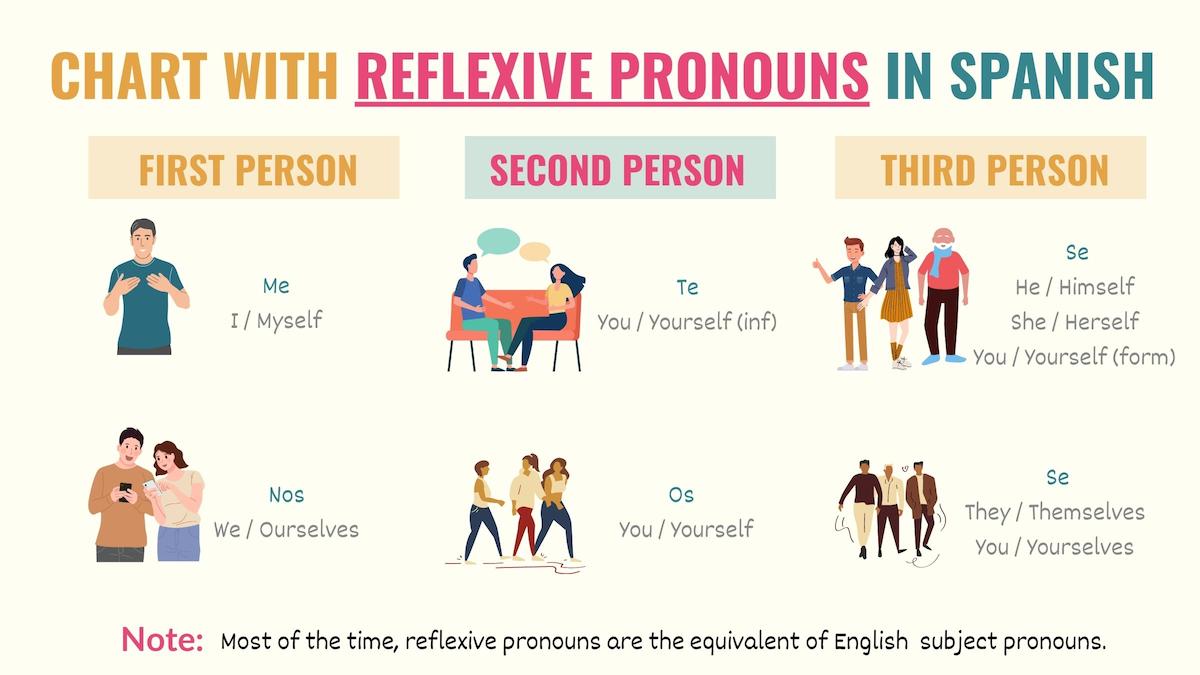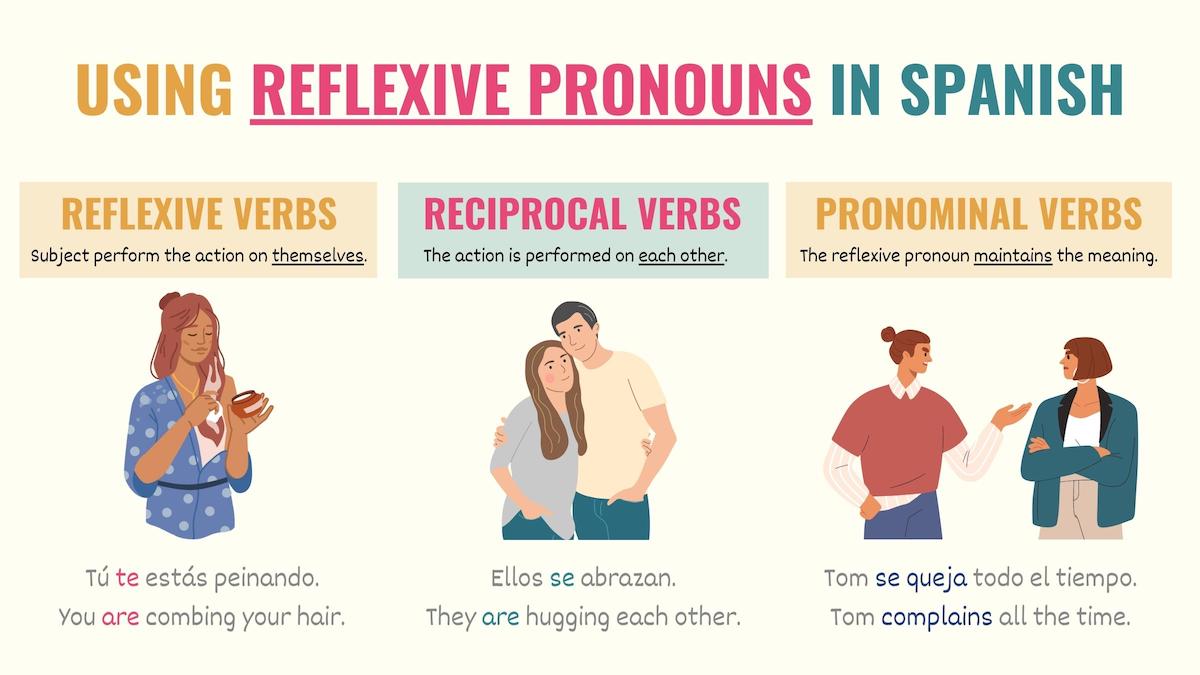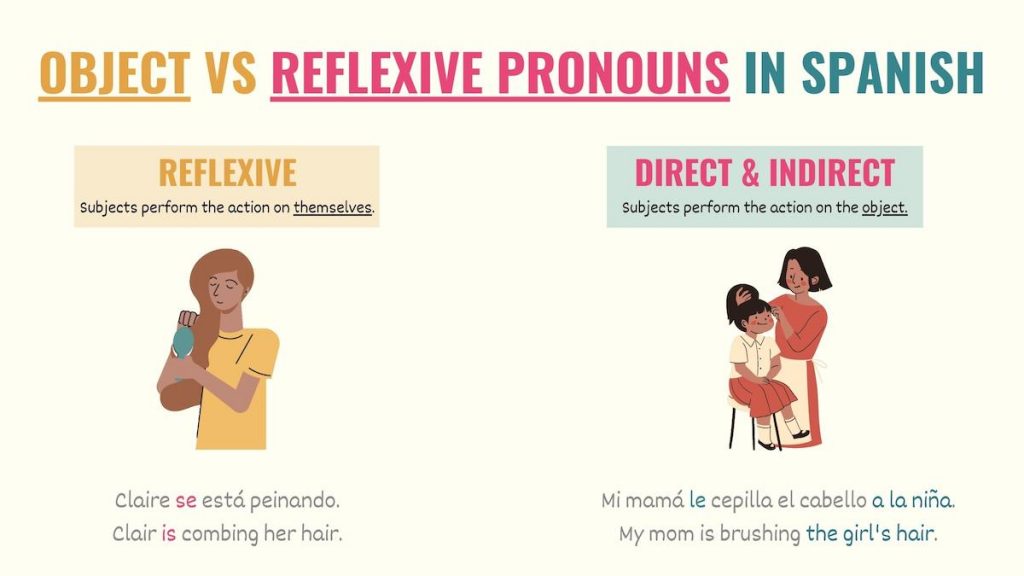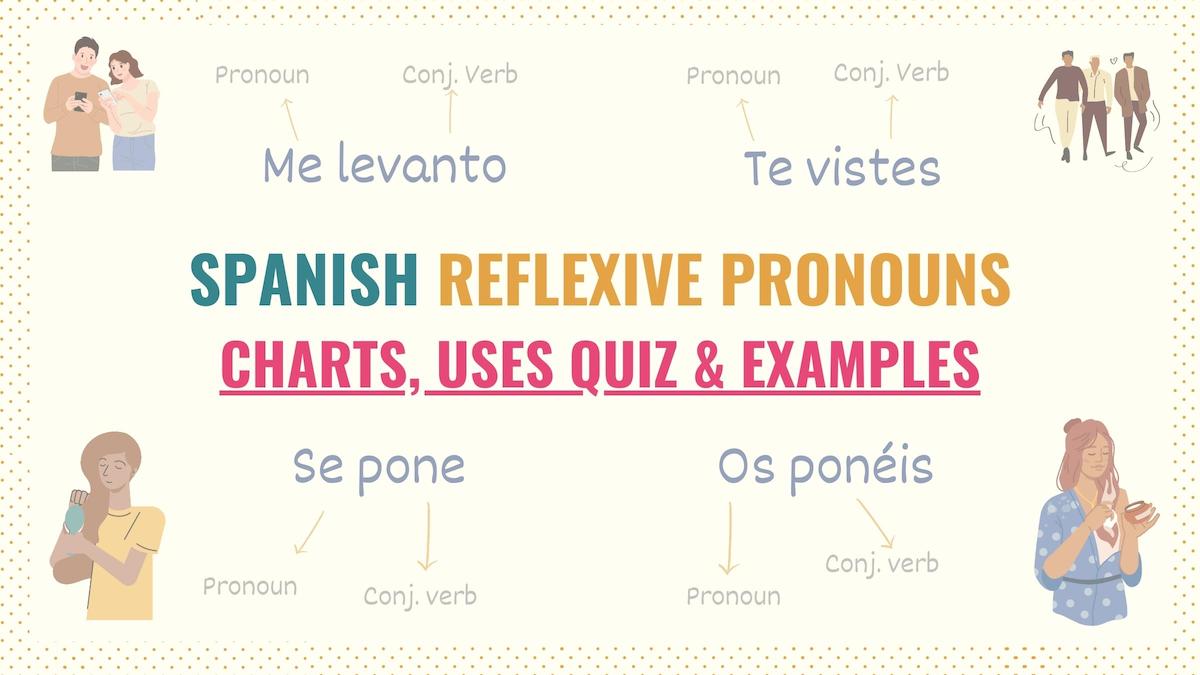Reflexive pronouns are one of the most important and basic type of pronouns in Spanish. In fact, you’ll need them daily. Because they’re such a crucial part of speech, in this guide to Spanish reflexive pronouns, we’ll go over:
- List of Reflexive Pronouns
- How to Conjugate Reflexive Pronouns
- Direct & Indirect vs Reflexive Pronouns
- Key Points
Let’s get to it!
What Are Reflexive Pronouns in Spanish?
In Spanish, there are six reflexive object pronouns. Half are singular, and half are plural. Below is a list of reflexive pronouns in Spanish.
Singular Reflexive Pronouns:
- Me: I / Myself
- Te: You / Yourself (informal)
- Se: He – Himself / She – Herself / You – Yourself (formal)
Plural Reflexive Pronouns:
- Nos: We / Ourselves
- Os*: You / Yourselves (Plural Castilian)
- Se: They – Themselves / You – Yourself (plural)
Notice that se is used for both the third person singular and plural: Ella se baña or ellas se bañan.
Reflexive pronouns can be translated as myself, herself, and similar forms when adding emphasis to a sentence. However, most of the time, they’re the equivalent of subject pronouns (I, you, we, etc). Check the following examples:
Yo me baño.
I shower.
Me dije a mí misma que era mala idea.
I told myself that it was a bad idea.

Take Note: The reflexive pronoun os is only necessary if you’re learning Castilian Spanish. So, in Latin American Spanish, the reflexive pronouns are me, te, se (singular and plural), and nos.
When to Use Spanish Reflexive Pronouns?
Often, people think that reflexive pronouns are exclusively used when conjugating reflexive verbs. However, these words are also used in other contexts.
Reflexive object pronouns in Spanish are used with:
- Reflexive verbs: To express that someone is performing the action on themselves. In other words, the subject of a sentence is also the object. These actions are often related to daily routines. For example: Yo me ducho.
- Reciprocal verbs: To communicate that two or more people perform the action on each other (reciprocity). Only use plural reflexive pronouns. For instance: Ellos se abrazan.
- Pronominal verbs: This is a type of Spanish verb that ends in ‘se’ and needs reflexive pronouns to keep their meaning. Here is an example: Tú siempre te quejas.

A verb ending with se (despertarse, bañarse, quejarse, etc) must follow the conjugation of reflexive verbs.
Take Note: Pronominal verbs like quejarse, arrepentirse, comerse, or negarse use reflexive pronouns to keep their meaning. However, they’re neither reciprocal nor express that people perform the action on themselves. Although reflexive verbs are pronominal, not all pronominal verbs are reflexive.
How to Conjugate Verbs with Reflexive Pronouns?
In Spanish, conjugating reflexive pronouns means that you must change the se in the verb’s infinitive ending for the correct reflexive pronoun.
You must also conjugate your verb based on its conjugation model, including any potential stem changes or irregularities.
Check this example of a conjugated verb in the present tense:
| Levantarse | Ponerse | Vestirse |
|---|---|---|
| Me levanto | Me pongo | Me visto |
| Te levantas | Te pones | Te vistes |
| Se levanta | Se pone | Se viste |
| Nos levantamos | Nos ponemos | Nos vestimos |
| Os levantáis | Os ponéis | Os vestís |
| Se levantan | Se ponen | Se visten |
Sentences using reflexive pronouns can omit subject pronouns (yo, tú). This is because the verb conjugation and reflexive pronoun imply who the subject of the sentence is.
Here are some examples of how to conjugate verbs using reflexive pronouns:
Ayer me bañé con agua fría.
Yesterday, I showered with cold water.
Te estás poniendo la camisa al revés.
You are putting your shirt backward.
Vamos a cambiarnos de ropa.
We are going to change our clothes.
Check example #3. Even though the second verb remained in its infinitive form, we still must use the corresponding reflexive pronoun.
Take Note: In Spanish, the conjugation of a reflexive verb dictates where to place reflexive pronouns. If you want to check how to conjugate verbs with these pronouns to different tenses, use despertarse’s conjugation as guidance.
Spanish Grammar: Reflexive vs Direct & Indirect Object Pronouns
As mentioned above, reflexive pronouns express that people perform an action on themselves (they’re both the subject and object of the sentence). However, we must use non-reflexive pronouns when performing the action upon something or someone else.
In other words, we use Spanish direct or indirect object pronouns when the subject and object of a sentence are not the same. See example sentences in the table below:
| Type of Pronoun Used | Example Sentence |
|---|---|
| Reflexive | Yo me visto. I dress. |
| Direct Object | ¿Y la bebé? Yo la voy a vestir. And the baby? I’m going to dress her. |
| Indirect Object | Yo le puse un vestido (a la bebé). I put a dress on her (to the baby). |
As shown in the examples above, indirect and direct object pronouns convey that another person receives and benefits from the action that someone else does.

Take Note: Some verbs like trabajar (to work) don’t need an object to have full meaning. They are called intransitive verbs and don’t work with reflexive, direct, or indirect object pronouns. For instance: Yo trabajo aquí (I work here).
Key Points
Reflexive pronouns are key for your daily conversations. Here are some key points we discussed in this guide:
- There are five reflexive pronouns: me, te, se*, os* and nos.
- The pronoun se is used for the third person singular and plural. Os is only used in Castilian Spanish.
- Reflexive pronouns are mainly used to express that someone performs an action on themselves.
- They are also used with reciprocal and pronominal verbs.
- Verbs that end with -arse, -irse, or -erse require a reflexive pronoun.
- When conjugating a verb, you must use the appropriate reflexive pronoun.
- According to Spanish grammar, direct and indirect object pronouns are used instead of reflexives when the subject and the object of a sentence are different.
Reflexive Pronouns Practice Quiz
If you want to practice what you just learned, here are some reflexive pronoun quizzes you can use:
Download the Reflexive Pronoun Cheat Sheets PDF
Spanish grammar topics can be tricky to master. I’ve created a downloadable PDF for you with the graphics, charts and key points from this guide so you can quickly learn how to use reflexive verbs and pronouns with ease!



